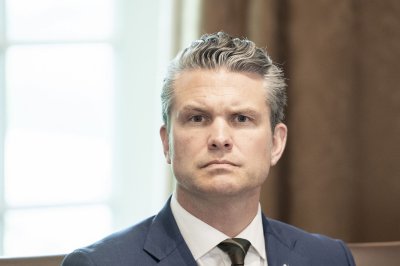
May 3 (UPI) — Changing military technologies, tactics and challenges require the U.S. Army to eliminate waste and modernize its capabilities to ensure “peace through strength,” Defense Secretary Pete Hegseth announced.
“To build a leaner, more lethal force, the Army must transform at an accelerated pace by divesting outdated, redundant and inefficient programs, as well as restructuring headquarters and acquisition systems,” Hegseth said Wednesday in a memo to senior Pentagon leadership..
The goal is to strategically realign forces to “optimize deterrence and rapid deployment … to defend the American homeland and deter China in the Indo-Pacific,” he explained.
To do that, Hegseth directed Secretary of the Army Dan Driscoll to “implement a comprehensive transformation strategy, streamline its force structure, eliminate wasteful spending, reform the acquisition process[and] modernize inefficient defense contracts.”
Doing so will “restore the warrior ethos and re-establish deterrence,” Hegseth said.
Improving operational capabilities
The Army must prioritize current resources to improve its long-range precision capabilities and establish an effective “golden dome” air and missile defense over the United States.
Hegseth also wants the Army to improve its cyber, electronic warfare and counter-space defensive capabilities.
He ordered Driscoll to accelerate the delivery of arms that can strike moving land and maritime targets, achieve electromagnetic and “air-littoral dominance,” and enable AI-driven command and control systems by 2027.
The Army also is to extend advanced manufacturing, including 3D printing and additive manufacturing, to Army units by the end of the year.
Hegseth also wants the Army to modernize production of munitions to sustain national defense during wartime and increase its forward presence in the Indo-Pacific region.
Driscoll must expand munitions stockpiles, troop deployments and joint exercises with Indo-Pacific allies and partners to maximize strategic capabilities within the region.
Modernizing the Army requires ending the procurement of obsolete systems and scaling back the use of redundant programs, including manned aircraft, Humvees and outdated unmanned aerial vehicles, Hegseth said.
He also wants Driscoll to lower the Army’s spending on obsolete weapons systems and “unnecessary climate-related initiatives” and eliminate wasteful contracts and excess travel funding.
Optimizing force structure and workforce
Driscoll must merge various headquarters to better enable the Army to effectively generate combat power and synchronize “kinetic and non-kinetic fires, space-based capabilities and unmanned systems,” Hegseth said.
Attack helicopter formations are to be reduced and restructured to make way for inexpensive drone swarms that can overwhelm targets, and outdated armor and aviation units are to be eliminated.
He wants Driscoll to downsize, consolidate or close redundant headquarters and review and consolidate operations across depots, arsenals and installations.
Skills and merit are to be prioritized to optimize force structure and achieve maximum military readiness, and general officer positions are to be reduced to streamline command structures.
Hegseth also ordered Driscoll to consolidate budgets and shift spending to ensure the rapid adaptation of new technology and include right-to-repair provisions in contracts that involve intellectual property constraints.
Contracts are to support faster adoption of critical technologies, including software and software-defined hardware.
Performance-based contracts are encouraged to reduce waste, and cost-effective multi-year procurement agreements are preferred.
“As the Army prepares to celebrate its 250th birthday, our nation requires her Army to move further, faster and fight harder than any other force on Earth,” Hegseth said.
“President [Donald] Trump and I will not let this nation down,” he concluded.